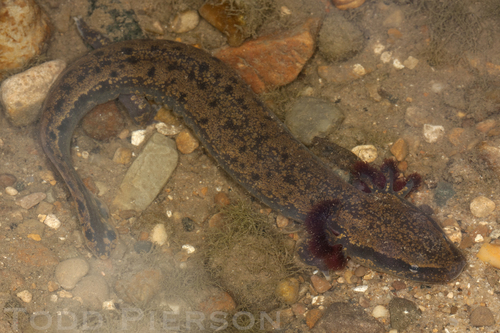
Mudpuppy
Meet the mudpuppy (Necturus maculosus), an aquatic marvel with feathery gills and a camouflaged skin. This nocturnal salamander thrives in North American waters, playing a vital role in aquatic ecosystems by controlling insect populations. Its unique ability to remain aquatic throughout life sets it apart from other amphibians.
11-20 years
Lifespan
119.9 g
Weight
Length: 20 - 33 cm
Size
Brown, Grey, Red
Color
4-6 years
Age of Sexual Maturity
Least Concern
Conservation Status
Stable
Population Trend
Characteristics
The Necturus maculosus, commonly known as the mudpuppy, is an aquatic salamander found in rivers, lakes, and streams in North America. It has external gills, a flat head, and a mottled, brown and gray skin. Mudpuppies are nocturnal and can grow up to 40 cm in length.
Distribution Range of the Mudpuppy
Necturus maculosus, commonly known as the Mudpuppy, is native to North America. Its geographical distribution includes the Great Lakes region, as well as the Mississippi River basin, extending into parts of southern Canada and the eastern United States. Countries where it is found include the United States and Canada, specifically in regions like the Great Lakes, the Mississippi River, and some parts of the Appalachian Mountains.
Mudpuppy's Habitat
Environmental Conditions
The Mudpuppy typically inhabits freshwater environments. It is commonly found in rivers, streams, lakes, and ponds. These environments are characterized by clear, slow to moderate flowing water with abundant cover such as rocks, logs, and vegetation. The species prefers a climate that ranges from temperate to cool, reflecting the seasonal variations in its native regions.
Ecological Niche
Necturus maculosus occupies an ecological niche as both a predator and prey within its aquatic ecosystem. It feeds on a variety of aquatic organisms, including insects, snails, and small fish, contributing to controlling the populations of these species. Moreover, the Mudpuppy is well-adapted to life underwater, possessing external gills that allow it to extract oxygen from the water, thus rarely needing to surface. Its nocturnal lifestyle helps it avoid predators and efficiently hunt for food.
Copyright @ Nature Style Limited. All Rights Reserved.
 English
English